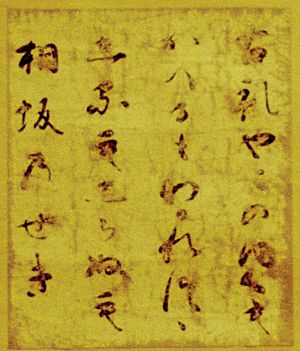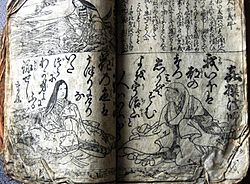Ogura Hyakunin Isshu facts for kids

The Hyakunin Isshu (pronounced "Hyah-koo-nin Ee-shoo") is a famous collection of one hundred Japanese poems, each written by a different poet. Its name means "one hundred people, one poem [each]". This collection is also the basis for a popular Japanese card game called uta-garuta.
The most well-known version was put together by a famous poet named Fujiwara no Teika (1162–1241). He created it while living in the Ogura area of Kyoto. Because of this, it's often called the Ogura Hyakunin Isshu.
Contents
How the Collection Was Made
We know how the Hyakunin Isshu came to be from Teika's diary, called the Meigetsuki. His son, Fujiwara no Tameie, asked Teika to choose one hundred poems. These poems were for Tameie's father-in-law, Utsunomiya Yoritsuna, who was decorating his new home near Mount Ogura. Teika wrote these poems beautifully on special sheets to decorate the screens in the house.
Later, artists added pictures to the collection. Hishikawa Moronobu (1618–1694) created woodblock portraits for each poet. Then, Katsukawa Shunshō (1726–1793) designed colorful prints for a special edition published in 1775.
During his lifetime, Teika was also known for other works. For example, in 1200, he made another collection of one hundred poems for the former Emperor Go-Toba. This one was called the Shōji Hyakushu.
Meet the Poets
The Hyakunin Isshu features a wide range of poets from different times in Japanese history. These include emperors, empresses, priests, and famous writers. Here are some of the poets included in this special collection:
- Emperor Tenji (天智天皇)
- Empress Jitō (持統天皇)
- Kakinomoto no Hitomaro (柿本人麻呂)
- Yamabe no Akahito (山部赤人)
- Sarumaru Dayū (猿丸大夫)
- Middle Counselor Yakamochi (中納言家持)
- Abe no Nakamaro (阿倍仲麻呂)
- Priest Kisen (喜撰法師)
- Ono no Komachi (小野小町)
- Semimaru (蝉丸)
- Councillor Takamura (参議篁)
- High Priest Henjō (僧正遍昭)
- Retired Emperor Yōzei (陽成院)
- Minister of the Left of Kawara (河原左大臣)
- Emperor Kōkō (光孝天皇)
- Middle Counselor Yukihira (中納言行平)
- Ariwara no Narihira Ason (在原業平朝臣)
- Fujiwara no Toshiyuki Ason (藤原敏行朝臣)
- Ise (伊勢)
- Prince Motoyoshi (元良親王)
- Priest Sosei (素性法師)
- Fun'ya no Yasuhide (文屋康秀)
- Ōe no Chisato (大江千里)
- Kanke (菅家)
- Minister of the Right of Sanjō (三条右大臣)
- Teishin-kō (貞信公)
- Middle Counselor Kanesuke (中納言兼輔)
- Minamoto no Muneyuki Ason (源宗于朝臣)
- Ōshikōchi no Mitsune (凡河内躬恒)
- Mibu no Tadamine (壬生忠岑)
- Sakanoue no Korenori (坂上是則)
- Harumichi no Tsuraki (春道列樹)
- Ki no Tomonori (紀友則)
- Fujiwara no Okikaze (藤原興風)
- Ki no Tsurayuki (紀貫之)
- Kiyohara no Fukayabu (清原深養父)
- Fun'ya no Asayasu (文屋朝康)
- Ukon (右近)
- Councillor Hitoshi (参議等)
- Taira no Kanemori (平兼盛)
- Mibu no Tadami (壬生忠見)
- Kiyohara no Motosuke (清原元輔)
- Acting Middle Counselor Atsutada (権中納言敦忠)
- Middle Counselor Asatada (中納言朝忠)
- Kentoku-kō (謙徳公)
- Sone no Yoshitada (曽禰好忠)
- Priest Egyō (恵慶法師)
- Minamoto no Shigeyuki (源重之)
- Ōnakatomi no Yoshinobu Ason (大中臣能宣朝臣)
- Fujiwara no Yoshitaka (藤原義孝)
- Fujiwara no Sanekata Ason (藤原実方朝臣)
- Fujiwara no Michinobu Ason (藤原道信朝臣)
- Mother of the Right Captain Michitsuna (右大将道綱母)
- Mother of the Honorary Grand Minister (儀同三司母)
- Upper Counselor Kintō (大納言公任)
- Izumi Shikibu (和泉式部)
- Murasaki Shikibu (紫式部)
- Daini no Sanmi (大弐三位)
- Akazome Emon (赤染衛門)
- Koshikibu no Naishi (小式部内侍)
- Ise no Taifu (伊勢大輔)
- Sei Shōnagon (清少納言)
- Master of the Left Capital Michimasa (左京大夫道雅)
- Acting Middle Counselor Sadayori (権中納言定頼)
- Sagami (相模)
- Senior High Priest Gyōson (大僧正行尊)
- Suō no Naishi (周防内侍)
- Retired Emperor Sanjō (三条院)
- Priest Nōin (能因法師)
- Priest Ryōzen (良暹法師)
- Upper Counselor Tsunenobu (大納言経信)
- Kii of Princess Yūshi's Household (祐子内親王家紀伊)
- Acting Middle Counselor Masafusa (権中納言匡房)
- Minamoto no Toshiyori Ason (源俊頼朝臣)
- Fujiwara no Mototoshi (藤原基俊)
- Lay Novice of Hosshō-ji Temple, former Kampaku and Chancellor of the Realm (法性寺入道前関白太政大臣)
- Retired Emperor Sutoku (崇徳院)
- Minamoto no Kanemasa (源兼昌)
- Master of the Left Capital Akisuke (左京大夫顕輔)
- Horikawa, attendant to Empress Taiken (待賢門院堀河)
- Later Tokudaiji Minister of the Left (後徳大寺左大臣)
- Priest Dōin (道因法師)
- Master of the Empress Dowager's Household Shunzei/Toshinari (皇太后宮大夫俊成)
- Fujiwara no Kiyosuke Ason (藤原清輔朝臣)
- Priest Shun'e (俊恵法師)
- Priest Saigyō (西行法師)
- Priest Jakuren (寂蓮法師)
- Attendant to Empress Kōka (皇嘉門院別当)
- Princess Shikishi (式子内親王)
- Attendant to Empress Inpu (殷富門院大輔)
- Gokyōgoku Regent and former Chancellor of the Realm (後京極摂政前太政大臣)
- Sanuki, attendant to retired Emperor Nijō (二条院讃岐)
- Minister of the Right of Kamakura (鎌倉右大臣)
- Councillor Masatsune (参議雅経)
- Former Senior High Priest Jien (前大僧正慈円)
- Lay Novice and former Chancellor of the Realm (入道前太政大臣)
- Acting Middle Counselor Teika/Sadaie (権中納言定家)
- Junior Second Rank Ietaka (従二位家隆)
- Retired Emperor Go-Toba (後鳥羽院)
- Retired Emperor Juntoku (順徳院)
Exploring Key Poems

Each poem in the Hyakunin Isshu tells a unique story or paints a picture with words. Here are a few examples:
Poem 1: A Farmer's Hardship
This poem by Emperor Tenji describes the tough life of farmers. Teika chose it from an older collection called the Gosen Wakashū. It speaks of simple, temporary shelters and the hard work of farming.
秋の田のかりほの庵の苫をあらみ
わが衣手は露にぬれつつ
aki no ta no kariho no io no toma o arami
waga koromode wa tsuyu ni nuretsutsu
In autumn paddies under the temporary dwelling made of rushes, my sleeves are wet with the dew.
(Gosen Wakashū 6:302)
Poem 2: A Summer Scene
This poem, written by Empress Jitō, creates a vivid image. Teika picked it from the Shin Kokin Wakashū. It talks about the change from spring to summer and the beautiful sight of white clothes drying on a sacred mountain.
春過ぎて夏来にけらし白妙の
衣干すてふ天の香具山
haru sugite natsu kinikerashi shirotae no
koromo hosu chō Ama no Kaguyama
Spring has passed, and the white robes of summer are being aired on fragrant Mount Kagu—beloved of the gods.
(Shin Kokin Wakashū 3:175)
This poem was likely inspired by an even older poem from the Man'yōshū.
Poem 26: A Royal Request
This poem is linked to a specific event involving Fujiwara no Tadahira. After stepping down as emperor, Emperor Uda visited Mount Ogura. He was so amazed by the beautiful autumn leaves that he asked Tadahira to encourage his son, Emperor Daigo, to visit the same spot.
The poem suggests that if the maple leaves on Mount Ogura had feelings, they would wait for the emperor to visit again. It shows how much people admired nature and respected their leaders.
小倉山峰のもみぢ葉心あらば
今ひとたびの行幸またなむ
Ogura-yama mine no momijiba kokoro araba
ima hitotabi no miyuki matanan
Maple leaves on Ogura mountain: if you had a heart, I would have you wait for one more royal visit!
(Shūi Wakashū 17:1128)
Poem 86: The Pain of Love
This poem by Saigyō explores the deep feelings of love and sadness. It was chosen from the Senzai Wakashū. The poet wonders if the moon makes him feel sad, even though his tears are from his own feelings of love.
嘆けとて月やは物を思はする
かこち顔なるわが涙かな
nageke to te tsuki ya wa mono wo omowasuru
kakochi-gao naru waga namida ka na
How could the moon make me fall into thought by saying "Lament!"? Although it is attributed to me being in love, I attribute my tears falling down to the moon.
(Senzai Wakashū 15:926)
English Versions of the Poems
The Ogura Hyakunin Isshu has been translated into many languages, including English, many times. The first English translation was Hyaku Nin Isshu in English by Yone Noguchi in 1907.
Other popular English translations include:
- William N. Porter, A Hundred Verses from Old Japan (1909)
- Clay MacCauley, Hyakunin-isshu (Single Songs of a Hundred Poets) (1917)
- Tom Galt, The Little Treasury of One Hundred People, One Poem Each (1982)
- Joshua S. Mostow, Pictures of the Heart: The Hyakunin Isshu in Word and Image (1996)
- Peter MacMillan, One Hundred Poets, One Poem Each: A Treasury of Classical Japanese Verse (2008; Penguin Classics, revised edition 2018)
- Emiko Miyashita and Michael Dylan Welch, 100 Poets: Passions of the Imperial Court (2008)
Other Collections Like It
Many other poetry collections have been created using the same idea: one hundred poems by one hundred poets. These often include "hyakunin isshu" in their names. An example is the Aikoku Hyakunin Isshu, or One Hundred Patriotic Poems by One Hundred Poets, from the World War II era. Another is the Kyōka Hyakunin Isshu, which is a funny version of the original Ogura collection.
The Fun Card Game
Teika's poetry collection is the foundation for the popular Japanese card game called karuta. This game has been enjoyed by people in Japan since the Edo period.
There are many ways to play games with the Hyakunin Isshu cards in Japan. One common game is Uta-garuta, which is also the basis for competitive karuta (called kyōgi karuta).
See also
 In Spanish: Hyakunin Isshu para niños
In Spanish: Hyakunin Isshu para niños
- Nisonin, Kyoto
- Shigureden, a museum in Kyoto about this subject


